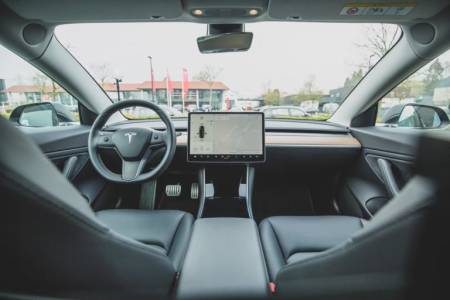
TESLA AUTOPILOT HACKED.
 The Tesla Autopilot system has been hacked, according to security group Tencent Keen Security Labs. They published a report in March 2019 revealing how to trick a Tesla’s Autopilot system into veering into another lane on the freeway. It seems that the camera sensors were simply ‘tricked’ by placing stickers on the roadway that caused the system to change lanes. Presumably mistaking the stickers for debris.
The Tesla Autopilot system has been hacked, according to security group Tencent Keen Security Labs. They published a report in March 2019 revealing how to trick a Tesla’s Autopilot system into veering into another lane on the freeway. It seems that the camera sensors were simply ‘tricked’ by placing stickers on the roadway that caused the system to change lanes. Presumably mistaking the stickers for debris.
ENGINE CONTROL UNIT
Tesla’s Autopilot system engine control unit (ECU) can be also be hacked. Access can be gained through root security weaknesses in software version 18.6.1. Access that can gain remote control of a Tesla Model S steering wheel. The researchers were able to gain control of the steering wheel without actually touching it. The researchers were also able to gain control of the windshield’s auto wipers, which Tesla claims has now been fixed.
ADVANCED DRIVER-ASSISTANCE
The Advanced Driver-Assistance System feature offered by Tesla that gives advanced Level 2 autonomous driving. It features lane centering, cruise control that maintains safe speeds and distances. Also the ability to self-park. The potential to automatically change lanes with driver’s approval. As well as enabling the car to be called remotely to and from a garage or parking spot.
LEVELS OF AUTONOMY
Autonomous features of self driving vehicles are ordered by the level of autonomy they provide. The following levels are courtesy of a TechRepublic Article available in full here.
LEVEL 0: Is very basic, the driver controls pretty much everything, except possible cruise control for highway driving.
LEVEL 1: The driver still controls most things, but various things like steering and acceleration can be handled automatically.
LEVEL 2: “Both steering and acceleration/ deceleration using information about the driving environment” is automated, like cruise control and lane-centering. It means that the “driver is disengaged from physically operating the vehicle. Either by having his or her hands off the steering wheel AND foot off the pedal at the same time”. According to SAE guide available here.
LEVEL 3: Drivers are still needed in level 3 cars. But being able to completely shift “Safety-Critical Functions” to the vehicle, under certain traffic or environmental conditions. It means that the driver is still present and will intervene if necessary. However, is not required to monitor the situation in the same way a driver does for the previous levels.
LEVEL 4: This is what is meant by “fully autonomous”. Level 4 vehicles are “designed to perform all safety-critical driving functions and monitor roadway conditions for an entire trip”. However, it’s important to note that this is limited to the “operational design domain (ODD)” of the vehicle. Meaning it does not cover every driving scenario.
LEVEL 5: This refers to a fully-autonomous system that expects the vehicle’s performance to equal that of a human driver. And in every driving scenario. Including extreme environments like dirt roads that are unlikely to be navigated by driverless vehicles in the near future.
TESLA’S RESPONSE
“It is not a realistic concern given that a driver can easily override Autopilot at any time by using the steering wheel or brakes and should always be prepared to do so”. A spokesperson for Tesla, regarding the hack, said.
THE ISSUE OF LIABILITY
So what does that mean to the law? Manufacturers and safety officials see driver-less cars reducing the number of accidents. And by as much as 80% by the year 2040. Surprised? Yes, I was too. But who pays if a self-driving car hits your vehicle? Who is to blame or who carries the liability in an accident involving one. These things and more are going to present the legal community with many challenges. Not to mention the milestone decisions to come in the not so distant future.
Have you, or someone that you love, been injured in a vehicle accident of any kind? We recommend seeking an attorney that can help you navigate the difficult claims processes.
